Synergistic Effect of MoS2 and SiO2 Nanoparticles as Lubricant Additives for Magnesium Alloy–Steel Contacts
Abstract
:1. Introduction
2. Experimental
2.1. Materials
2.2. Friction and Wear Tests
2.3. Worn Surface Analysis
3. Results and Discussion
3.1. Friction and Wear Performances
3.2. The Capacity of Carrying Load
3.3. Lubrication-Film Stability
3.4. FESEM and XPS Analyses of the Worn Surfaces
3.5. Lubrication Mechanism of SiO2/MoS2 Hybrid Nanolubricants
4. Conclusions
- (1)
- 1.0 wt % MoS2 nanolubricants, 0.1 wt % SiO2 nanolubricants, and SiO2/MoS2 hybrid nanolubricants presented superior friction-reducing and anti-wear behaviors as well as a high load-carrying capacity. The optimal friction reducing and anti-wear capability was obtained for the combinative addition of 1.0 wt % nano-MoS2 and 0.1 wt % nano-SiO2 into the base oil.
- (2)
- 0.1 wt % SiO2 mixed with 1.0 wt % nano-MoS2 addition into the base oil showed a 21.8% reduction in the friction coefficient and 8.6% reduction in the wear volume compared with the 1.0 wt % MoS2 nanolubricants.
- (3)
- Under the lubrication of the SiO2:MoS2 (0.1:1.0) hybrid nanolubricants, a complex tribo-chemical film that mainly contains MoO3 and MgSO4 through chemical reaction plus the absorbed nanomaterial which is from the lubricant additive itself is generated on the worn surfaces.
Acknowledgments
Author Contributions
Conflicts of Interest
References
- Sunil, B.R.; Ganesh, K.V.; Pavan, P.; Vadapalli, G.; Swarnalatha, C.; Swapna, P.; Bindukumar, P.; Reddy, G.P.K. Effect of aluminum content on machining characteristics of AZ31 and AZ91 magnesium alloys during drilling. J. Magnes. Alloys 2016, 4, 15–21. [Google Scholar] [CrossRef]
- Grubac, Z.; Metikos-Hukovic, M.; Roncevic, I.S.; Petravic, M.; Peter, R. Functionalization of Biodegradable Magnesium Alloy Implants with Alkylphosphonate Self-Assembled Films. Mater. Sci. Eng. C 2013, 33, 2152–2158. [Google Scholar] [CrossRef] [PubMed]
- Tang, C.P.; Liu, W.H.; Chen, Y.Q.; Liu, X.; Deng, Y.L. Effects of thermal treatment on microstructure and mechanical properties of a Mg-Gd-based alloy plate. Mater. Sci. Eng. A 2016, 659, 63–75. [Google Scholar] [CrossRef]
- Khramov, A.N.; Balbyshev, V.N.; Kasten, L.S.; Mantz, R.A. Sol–Gel Coatings with Phosphonate Functionalities for Surface Modification of Magnesium Alloys. Thin Solid Films 2006, 514, 174–181. [Google Scholar] [CrossRef]
- Lu, X.; Feng, X.; Zuo, Y.; Zheng, C.; Lu, S.; Xu, L. Evaluation of the micro-arc oxidation treatment effect on the protective performance of a Mg-rich epoxy coating on AZ91D magnesium alloy. Surf. Coat. Technol. 2015, 270, 227–235. [Google Scholar] [CrossRef]
- Kavyani, M.; Ebrahimi, G.R.; Sanjari, M.; Haghshenas, M. Texture evaluation in warm deformation of an extruded Mg–6Al–3Zn alloy. J. Magnes. Alloys 2016, 4, 89–98. [Google Scholar] [CrossRef]
- Espinosa, T.; Jiménez, A.E.; Martínez-Nicolás, G.; Sanes, J.; Bermúdez, M.D. Abrasion Resistance of Magnesium Alloys with Surface Films Generated from Phosphonate Imidazolium Ionic Liquids. Appl. Surf. Sci. 2014, 320, 267–273. [Google Scholar] [CrossRef]
- Zhang, H.; Cheng, W.; Fan, J.; Xu, B.; Dong, H. Improved mechanical properties of AZ31 magnesium alloy sheets by repeated cold rolling and annealing using a small pass reduction. Mater. Sci. Eng. A 2015, 637, 243–250. [Google Scholar] [CrossRef]
- Prakash, K.S.; Balasundar, P.; Nagaraja, S.; Gopal, P.M.; Kavimani, V. Mechanical and wear behaviour of Mg–SiC–Gr hybrid composites. J. Magnes. Alloys 2016, 4, 197–206. [Google Scholar] [CrossRef]
- Jiménez, A.E.; Rossi, A.; Fantauzzi, M.; Espinosa, T.; Arias-Pardilla, J.; Martínez-Nicolás, G.; Bermúdez, M.D. Surface Coating from Phosphonate Ionic Liquid Electrolyte for the Enhancement of the Tribological Performance of Magnesium Alloy. ACS Appl. Mater. Interface 2015, 11, 10337–10347. [Google Scholar] [CrossRef] [PubMed]
- Xie, H.M.; Jiang, B.; Wang, Q.H.; Xia, X.S.; Pan, F.S. Effects of combined additions of SiO2 and MoS2 nanoparticles as lubricant additive on the tribological properties of AZ31 magnesium alloy. Sci. China Technol. Sci. 2016, 59, 689–698. [Google Scholar] [CrossRef]
- Dennis, J.E.S.; Jin, K.; John, V.T.; Pesika, N.S. Carbon microspheres as ball bearings in aqueous-based lubrication. ACS Appl. Mater. Interface 2011, 3, 2215–2218. [Google Scholar] [CrossRef] [PubMed]
- Gu, K.C.; Chen, B.S.; Wang, X.M.; Wang, J.; Fang, J.H.; Wu, J.; Yang, X. Preparation, Friction, and Wear Behaviors of Cerium-Doped Anatase Nanophases in Rapeseed Oil. Ind. Eng. Chem. Res. 2014, 53, 6249–6254. [Google Scholar] [CrossRef]
- Huang, W.J.; Du, C.H.; Li, Z.F.; Liu, M.; Liu, W.M. Tribological characteristics of magnesium alloy using N-containing compounds as lubricating additives during sliding. Wear 2006, 260, 140–148. [Google Scholar] [CrossRef]
- Huang, W.J.; Fu, Y.; Wang, J.; Li, Z.F.; Liu, M. Effect of chemical structure of borates on the tribological characteristics of magnesium alloy during sliding. Tribol. Int. 2005, 38, 775–780. [Google Scholar] [CrossRef]
- Xia, Y.Q.; Jia, Z.F.; Jia, J.H. Advanced Tribology; Springer: Berlin/Heidelberg, Germany, 2010. [Google Scholar]
- Yan, L.; Yue, W.; Wang, C.; Wei, D.; Xu, B. Comparing tribological behaviors of sulfur- and phosphorus-free organomolybdenum additive with ZDDP and MoDTC. Tribol. Int. 2012, 53, 150–158. [Google Scholar] [CrossRef]
- Li, Z.P.; Li, X.F.; Zhang, Y.W.; Ren, T.H.; Zhao, Y.D.; Zeng, X.Q.; Heide, E. Tribological study of a highly hydrolytically stable phenylboronic acid ester containing benzothiazolyl in mineral oil. Appl. Surf. Sci. 2014, 308, 91–99. [Google Scholar] [CrossRef]
- Cai, M.; Liang, Y.; Zhou, F.; Liu, W. Tribological properties of novel imidazolium ionic liquids bearing benzotriazole group as the antiwear/anticorrosion additive in poly(ethylene glycol) and polyurea grease for steel/steel contacts. ACS Appl. Mater. Interfaces 2011, 3, 4580–4592. [Google Scholar] [CrossRef] [PubMed]
- Liu, Y.D.; Wang, C.B.; Yuan, J.J.; Liu, J.J. Investigation on anti-wear properties of sulfide layer on bearing steel lubricated by oil-containing FeS particles. Surf. Coat. Technol. 2010, 205, 470–474. [Google Scholar] [CrossRef]
- Flores-Castañeda, M.; Camps, E.; Camacho-López, M.; Muhl, S.; Garcia, E.; Figueroa, M. Bismuth nanoparticles synthesized by laser ablation in lubricant oils for tribological tests. J. Alloys Compd. 2014, 643, 67–70. [Google Scholar] [CrossRef]
- Sayuti, M.; Sarhan, A.A.; Hamdi, M. An investigation of optimum SiO2 nanolubrication parameters in end milling of aerospace Al6061-T6 alloy. Int. J. Adv. Manuf. Technol. 2013, 67, 833–849. [Google Scholar] [CrossRef]
- Sayuti, M.; Erh, O.M.; Sarhan, A.A.D.; Hamdi, M. Investigation on the morphology of the machined surface in end milling of aerospace AL6061-T6 for novel uses of SiO2 nanolubrication system. J. Clean. Prod. 2014, 66, 655–663. [Google Scholar] [CrossRef]
- Hu, K.H.; Liu, M.; Wang, Q.J.; Xu, Y.F.; Schraube, S.; Hu, X.G. Tribological properties of molybdenum disulfide nanosheets by monolayer restacking process as additive in liquid paraffin. Tribol. Int. 2009, 42, 33–39. [Google Scholar] [CrossRef]
- Kogovšek, J.; Remškar, M.; Mrzel, A.; Kalin, M. Influence of surface roughness and running-in on the lubrication of steel surfaces with oil containing MoS2 nanotubes in all lubrication regimes. Tribol. Int. 2013, 61, 40–47. [Google Scholar] [CrossRef]
- Mosleh, M.; Atnafu, N.D.; Belk, J.H.; Nobles, O.M. Modification of sheet metal forming fluids with dispersed nanoparticles for improved lubrication. Wear 2009, 267, 1220–1225. [Google Scholar] [CrossRef]
- Kalin, M.; Kogovšek, J.; Kovač, J.; Remškar, M. The Formation of Tribofilms of MoS2 Nanotubes on Steel and DLC-Coated Surfaces. Tribol. Lett. 2014, 55, 381–391. [Google Scholar] [CrossRef]
- Kogovšek, J.; Remškar, M.; Kalin, M. Lubrication of DLC-coated surfaces with MoS2 nanotubes in all lubrication regimes: Surface roughness and running-in effects. Wear 2013, 303, 361–370. [Google Scholar] [CrossRef]
- Xie, H.M.; Jiang, B.; He, J.J.; Xia, X.S.; Pan, F.S. Lubrication performance of MoS2 and SiO2 nanoparticles as lubricant additives in magnesium alloy-steel contacts. Tribol. Int. 2016, 93, 63–70. [Google Scholar] [CrossRef]
- Podgornik, B.; Kocijan, A.; Kocijan, A.; Donik, C. Tribological behaviour and lubrication performance of hexagonal boron nitride (h-BN) as a replacement for graphite in aluminium forming. Tribol. Int. 2015, 81, 267–275. [Google Scholar] [CrossRef]
- Zhang, L.L.; Pu, J.B.; Wang, L.; Xue, Q.J. Synergistic effect of hybrid carbon nanotube-graphene oxide as nanoadditive enhancing the frictional properties of ionic liquids in high vacuum. ACS Appl. Mater. Interface 2015, 7, 8592–8600. [Google Scholar] [CrossRef] [PubMed]
- Cizaire, L.; Vacher, B.; Le-Mogne, T.; Martin, J.M.; Rapoport, L.; Margolin, A.; Tenne, R. Mechanisms of ultra-low friction by hollow inorganic fullerene-like MoS2 nanoparticles. Surf. Coat. Technol. 2002, 160, 282–287. [Google Scholar] [CrossRef]
- Chacko, P.K.; Perikinalil, K.R.; Manu, V.T. Evaluation of the Tribological and Thermo-physical Properties of Coconut Oil Added with MoS2 Nanoparticles at Elevated Temperatures. Wear 2015, 330–331, 288–308. [Google Scholar]
- Wu, L.L.; Zhang, Y.J.; Yang, G.B.; Zhang, S.M.; Yu, L.G.; Zhang, P.Y. Tribological properties of oleic acid-modified zinc oxide nanoparticles as the lubricant additive in poly-alpha olefin and diisooctyl sebacate base oils. RSC Adv. 2016, 6, 69836–69844. [Google Scholar] [CrossRef]
- Rapoport, L.; Leshchinsky, V.; Lapsker, I.; Volovik, Y.; Nepomnyashchy, O.; Lvovsky, M.; Popovitz-Biro, R.; Feldman, Y.; Tenne, R. Tribological properties of WS2 nanoparticles under mixed lubrication. Wear 2003, 255, 785–793. [Google Scholar] [CrossRef]
- Marco, D.; Nadja, S.; Francesco, Z. Stability, Dynamics, and Lubrication of MoS2 Platelets and Nanotubes. Langmuir 2012, 28, 7393–7400. [Google Scholar]
- Cahangirov, S.; Ataca, C.; Topsakal, M.; Sahin, H.; Ciraci, S. Frictional figures of merit for single layerd nanostuctures. Phys. Rev. Lett. 2014, 108, 126103–126108. [Google Scholar] [CrossRef] [PubMed]
- Giacomo, L.; Elisa, M.; Tomas, P.; Maria, C.R. First principles comparative study on the interlayer adhesion and shear strenth of transition-metal dichalcogenides and graphene. Phys. Rev. B 2015, 92, 173–174. [Google Scholar]
- Qu, J.; Bansal, D.G.; Yu, B.; Howe, J.Y.; Luo, H.M.; Dai, S.; Li, H.Q.; Blau, P.J.; Bunting, B.G.; Mordukhovich, G.; et al. Antiwear Performance and Mechanism of an Oil-Miscible Ionic Liquid as a Lubricant Additive. ACS Appl. Mater. Interface 2012, 4, 997–1002. [Google Scholar] [CrossRef] [PubMed]
- Sia, S.Y.; Bassyony, E.Z.; Sarhan, A.A.D. Development of SiO2 nanolubrication system to be used in sliding bearings. Int. J. Adv. Manuf. Technol. 2014, 71, 1277–1284. [Google Scholar] [CrossRef]
- Tannous, J.; Dassenoy, F.; Lahouij, I.; Le Mogne, T.; Vacher, B.; Bruhács, A.; Tremel, W. Understanding the tribochemical mechanisms of IF-MoS2 nanoparticles under boundary lubrication. Tribol. Lett. 2011, 41, 55–64. [Google Scholar] [CrossRef]
- Koroteev, V.O.; Bulusheva, L.G.; Okotrub, A.V.; Yudanov, N.F.; Vyalikh, D.V. Formation of MoS2 nanoparticles on the surface of reduced graphite oxide. Phys. Status Solidi B 2011, 248, 2740–2743. [Google Scholar] [CrossRef]
- Li, X.; Cao, Z.; Zhang, Z.; Dang, H. Surface-modification in situ of nano-SiO2 and its structure and tribological properties. Appl. Surf. Sci. 2006, 252, 7856–7861. [Google Scholar] [CrossRef]
- Levita, G.; Restuccia, P.; Righi, M.C. Graphene and MoS2 interacting with water: A comparison by ab initio calculations. Carbon 2016, 107, 878–884. [Google Scholar] [CrossRef]
- Sia, S.Y.; Sarhan, A.A.D. Morphology investigation of worn bearing surfaces using SiO2 nanolubrication system. Int. J. Adv. Manuf. Technol. 2014, 70, 1063–1071. [Google Scholar] [CrossRef]
- Alazemi, A.A.; Etacheri, V.; Dysart, A.D.; Stacke, L.E.; Pol, V.G.; Sadeghi, F. Ultrasmooth submicrometer carbon spheres as lubricant additives for friction and wear reduction. ACS. Appl. Mater. Interface 2015, 7, 5514–5521. [Google Scholar] [CrossRef] [PubMed]
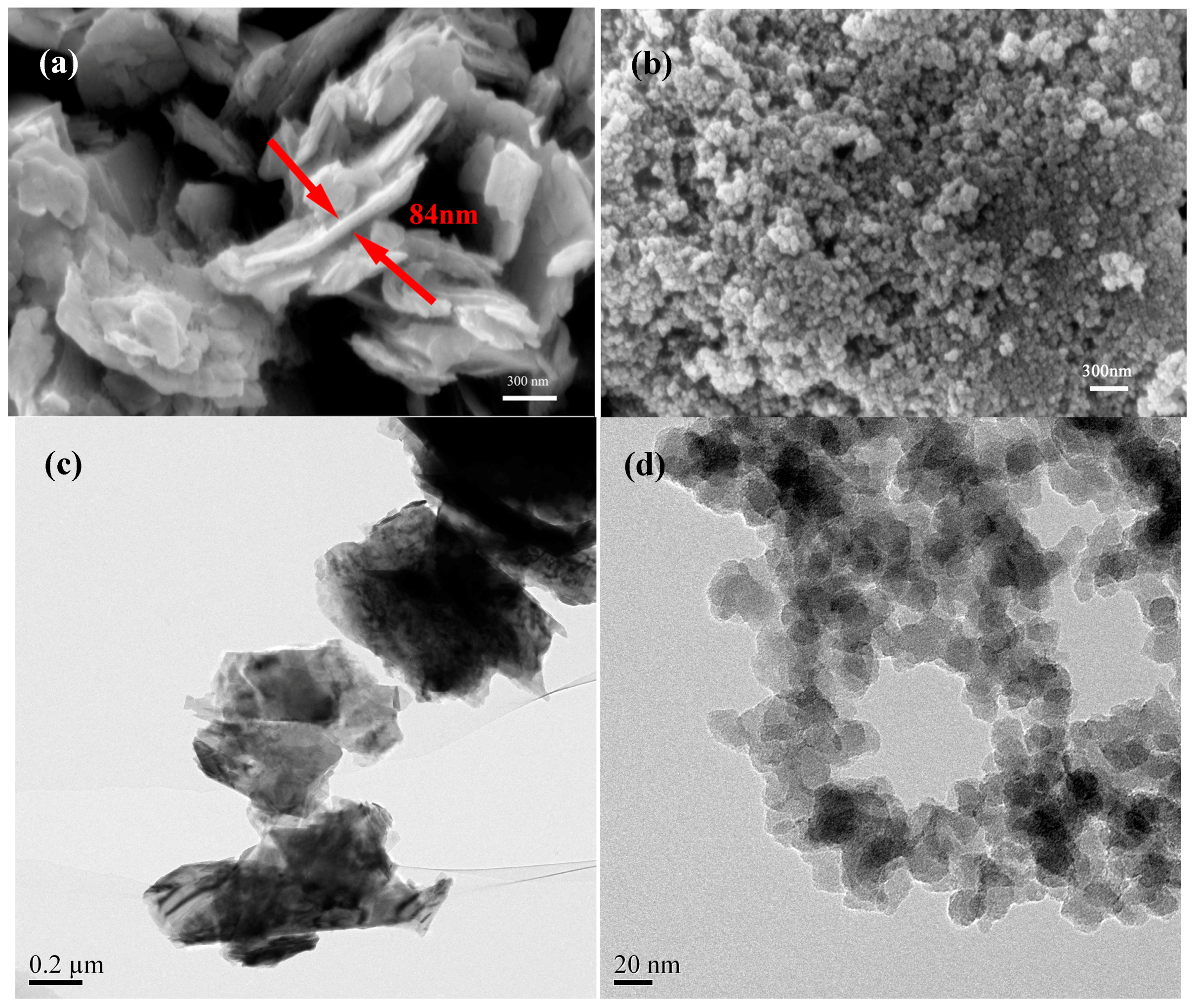
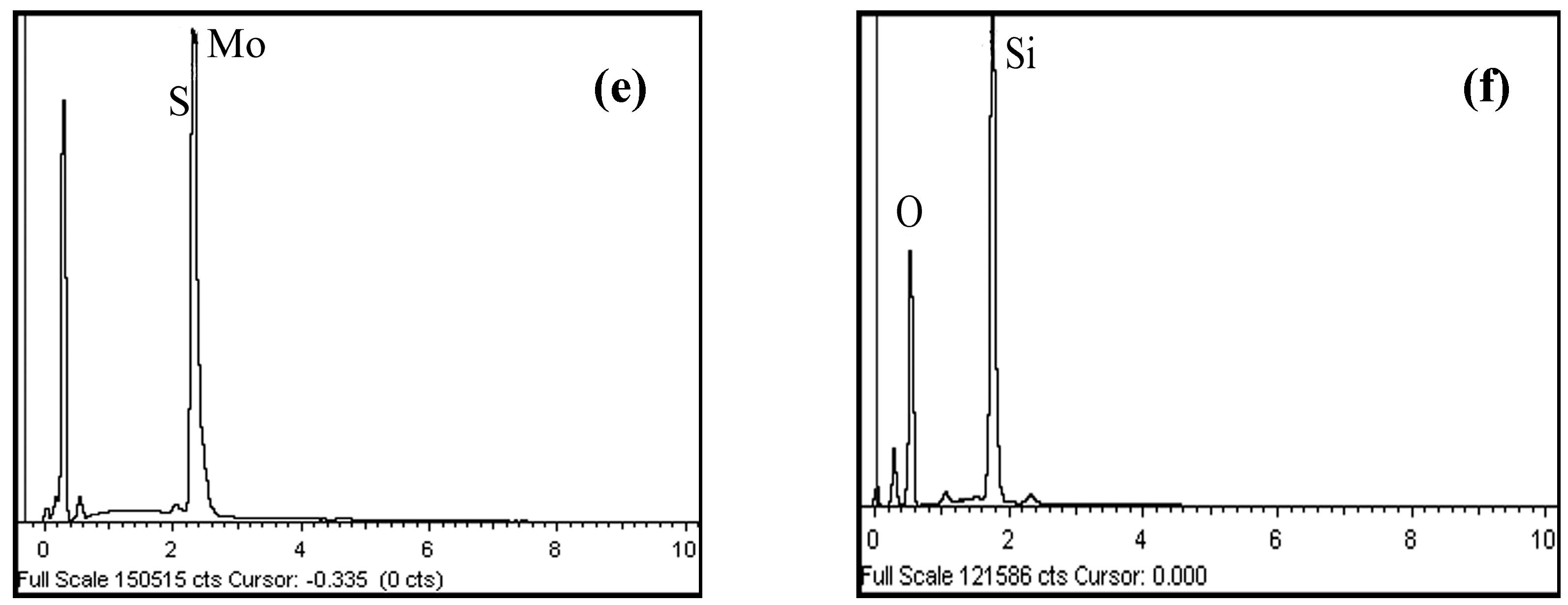
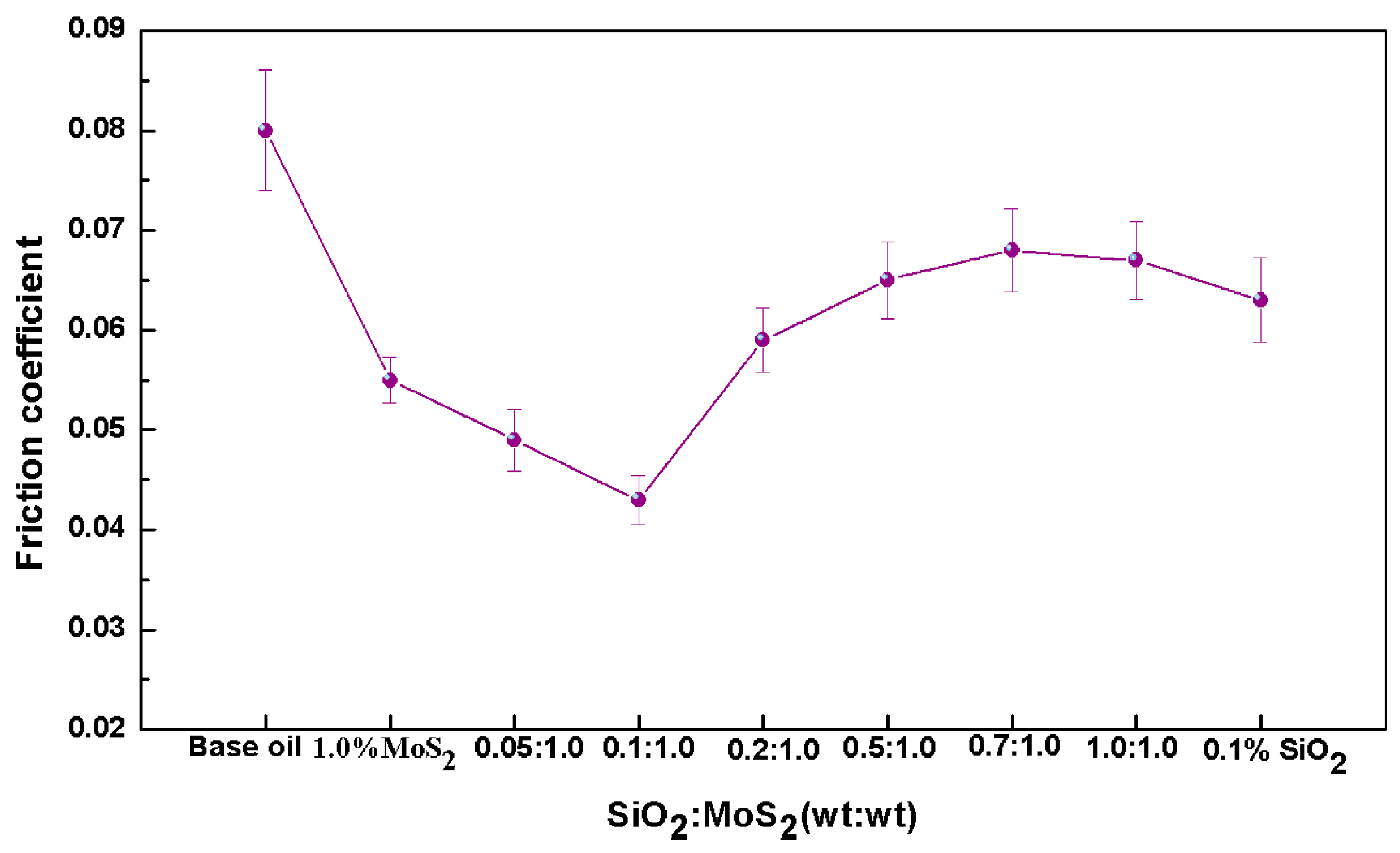
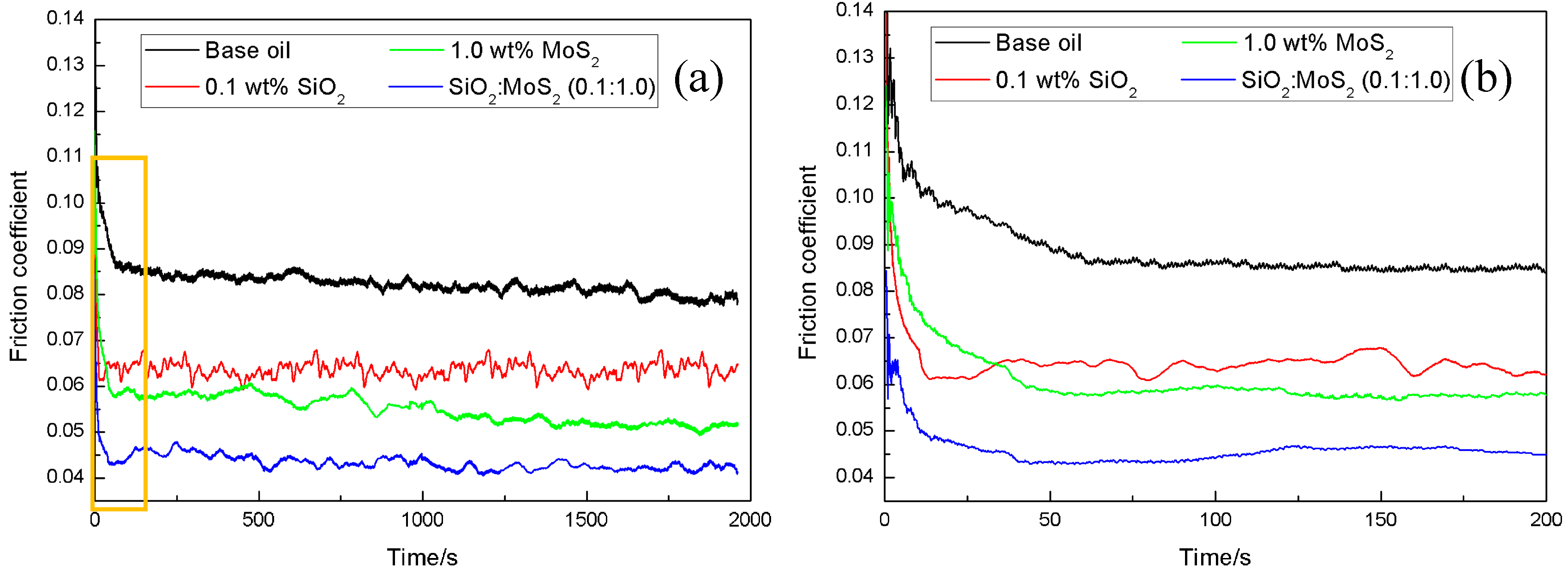
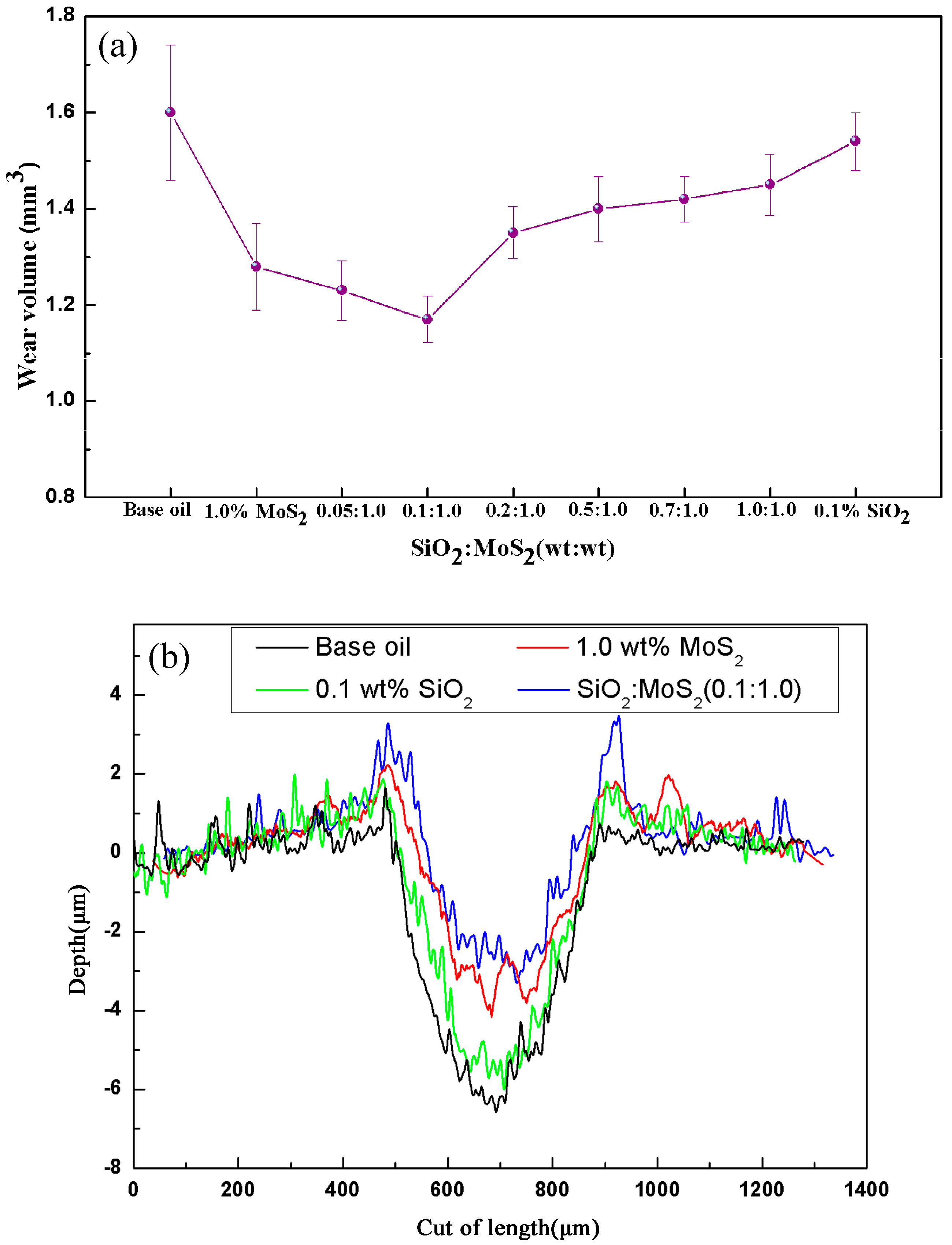
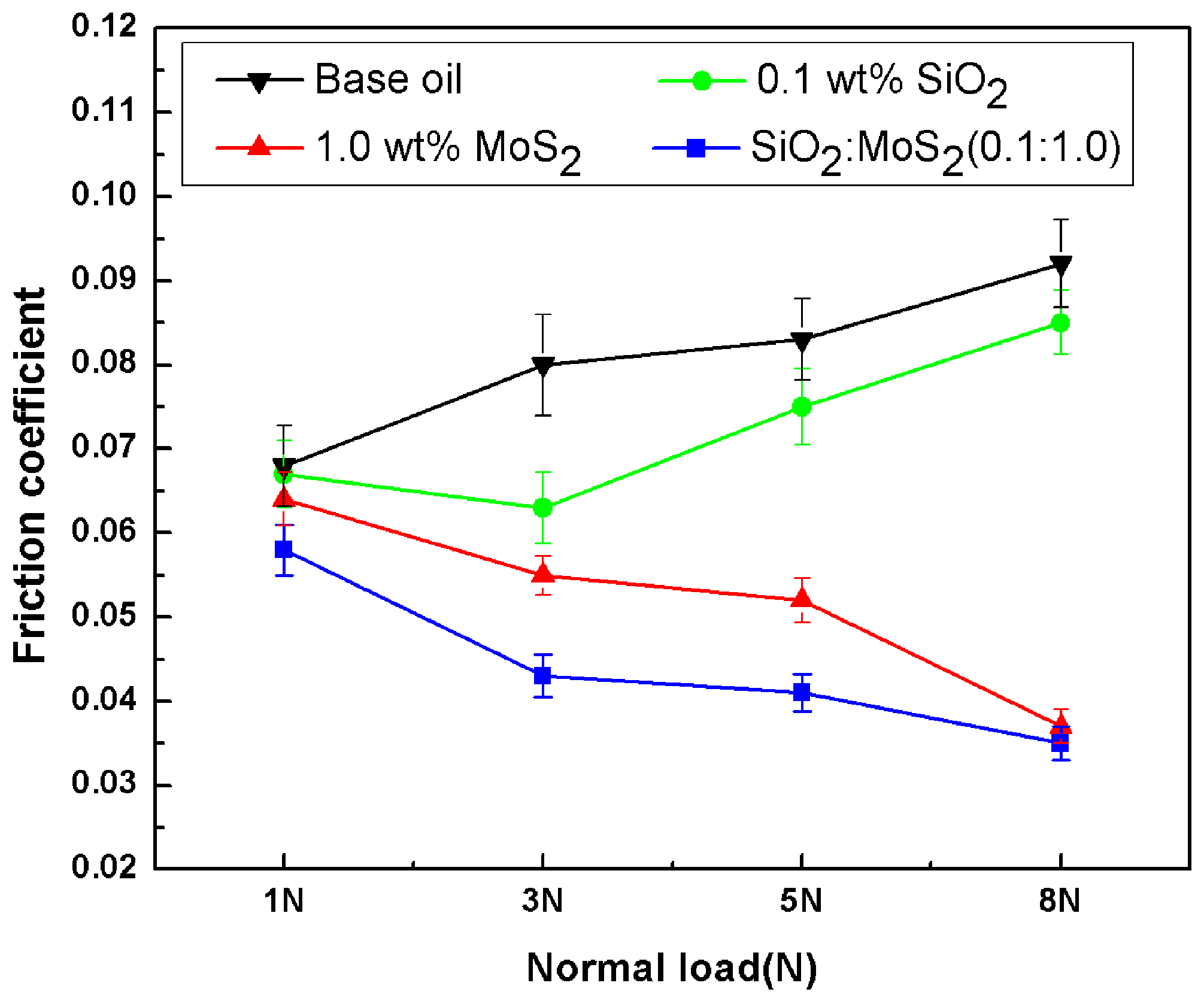
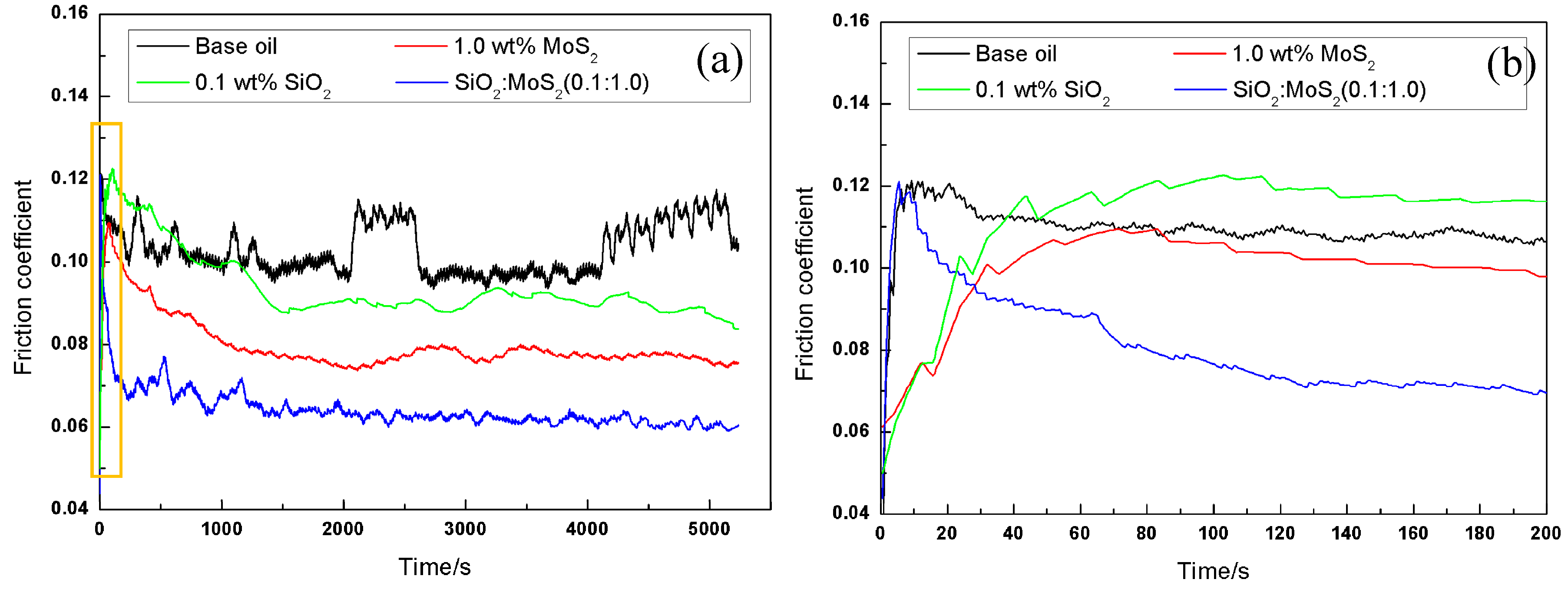
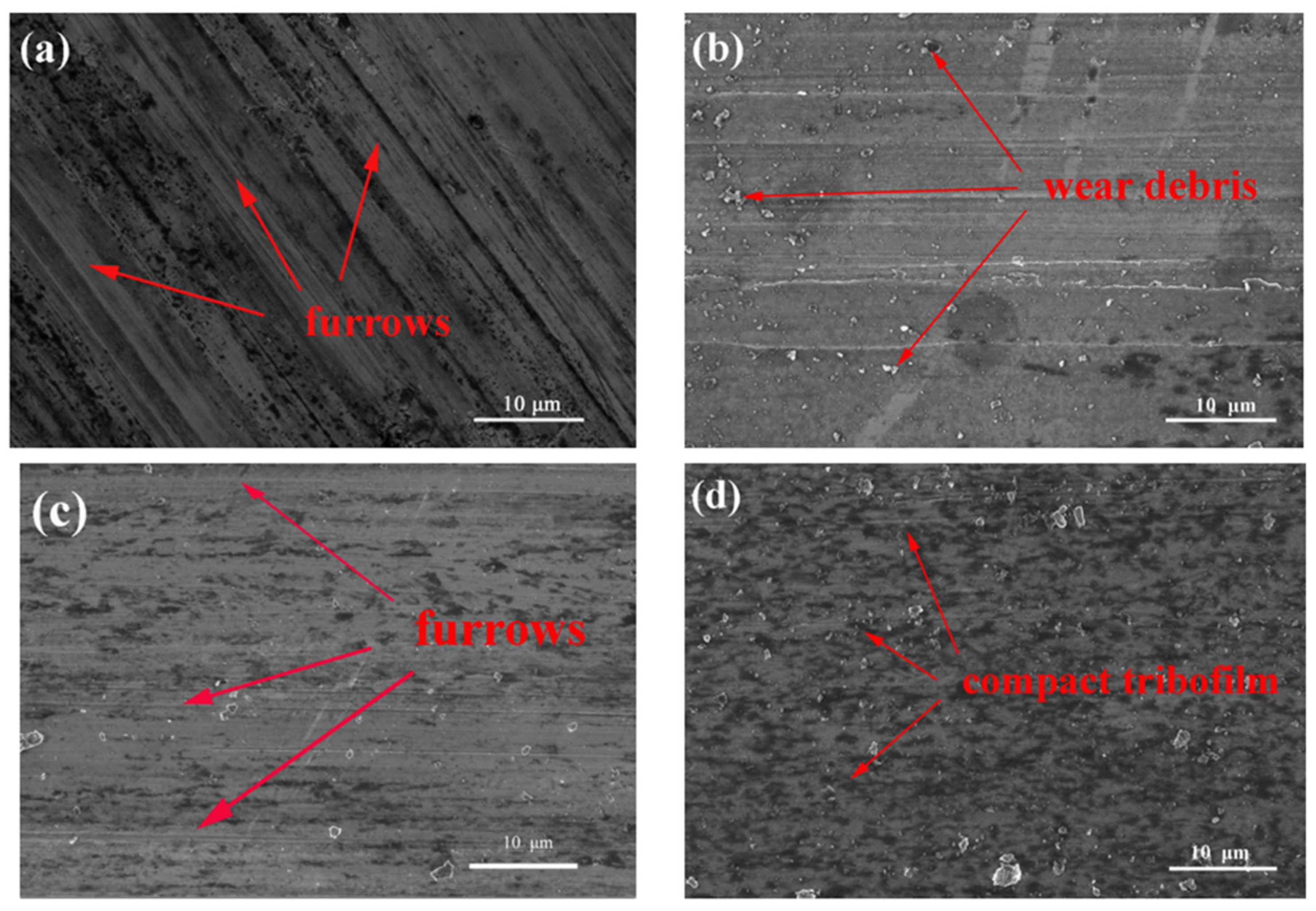
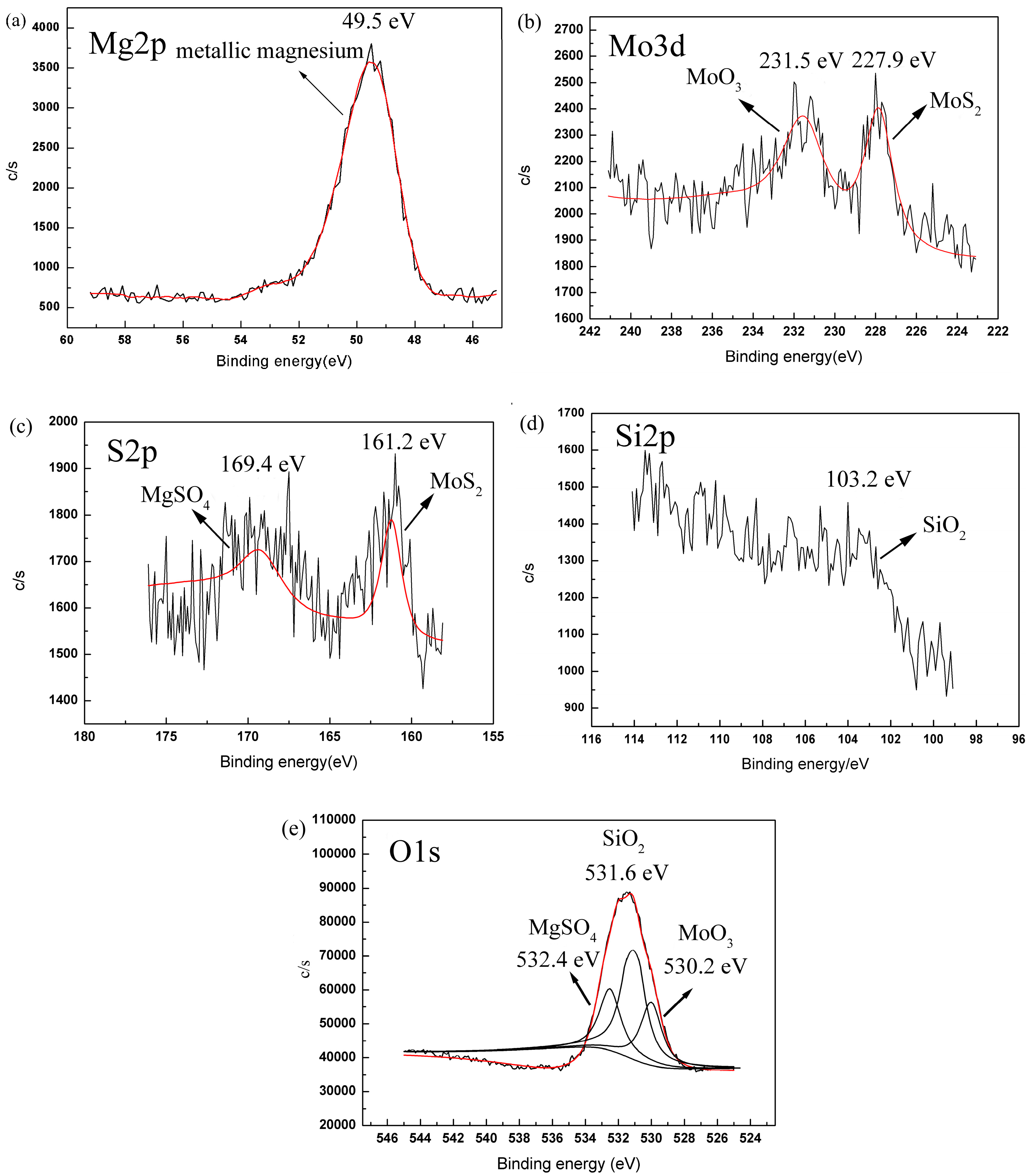
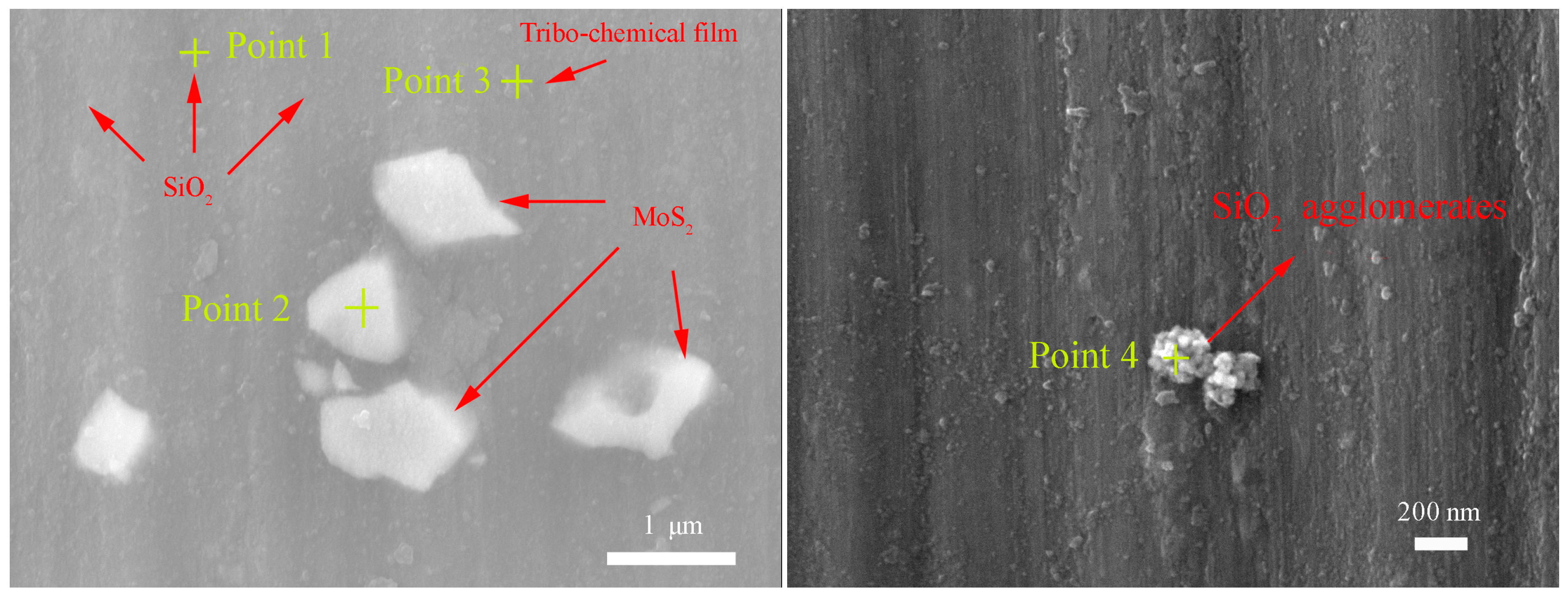
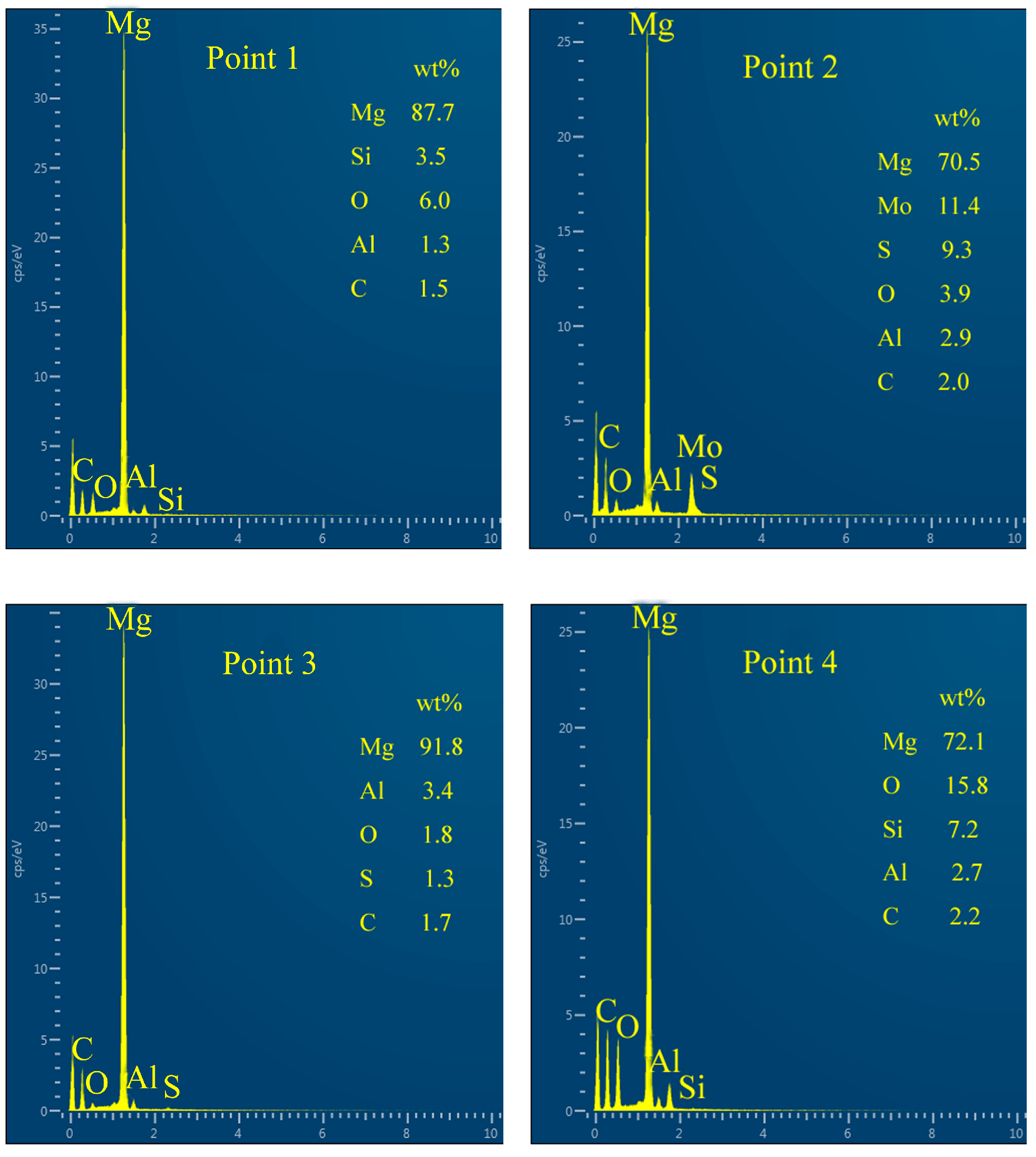
| Primary Characteristics | Kinematic Viscosity (40 °C) | Density (15 °C) | Content of Saturates | Content of Aromatics | Contents of Sulfur |
|---|---|---|---|---|---|
| EOT5# lubricant oil | 5.11 mm2/s | 0.856 g/cm3 | >90% | <1% | <0.03% |
© 2017 by the authors. Licensee MDPI, Basel, Switzerland. This article is an open access article distributed under the terms and conditions of the Creative Commons Attribution (CC BY) license (http://creativecommons.org/licenses/by/4.0/).
Share and Cite
Xie, H.; Jiang, B.; Hu, X.; Peng, C.; Guo, H.; Pan, F. Synergistic Effect of MoS2 and SiO2 Nanoparticles as Lubricant Additives for Magnesium Alloy–Steel Contacts. Nanomaterials 2017, 7, 154. https://doi.org/10.3390/nano7070154
Xie H, Jiang B, Hu X, Peng C, Guo H, Pan F. Synergistic Effect of MoS2 and SiO2 Nanoparticles as Lubricant Additives for Magnesium Alloy–Steel Contacts. Nanomaterials. 2017; 7(7):154. https://doi.org/10.3390/nano7070154
Chicago/Turabian StyleXie, Hongmei, Bin Jiang, Xingyu Hu, Cheng Peng, Hongli Guo, and Fusheng Pan. 2017. "Synergistic Effect of MoS2 and SiO2 Nanoparticles as Lubricant Additives for Magnesium Alloy–Steel Contacts" Nanomaterials 7, no. 7: 154. https://doi.org/10.3390/nano7070154





